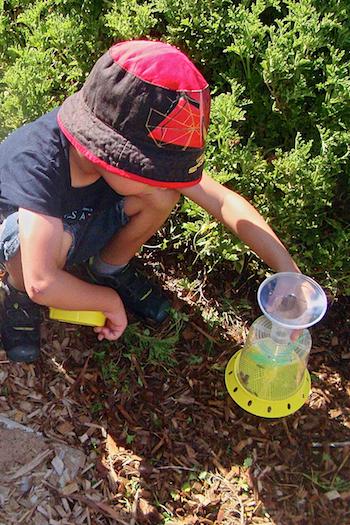Hunting for bugs
Duration/age

Yesterday you planted new seedlings in the garden and today when you look they are not there.
Where do you think they went? Did a giant rabbit sneak into the garden at night and take them home for dinner?
The insects and bugs have been eating our seedling during the night. We need to go bug hunting in our garden to find them.
Walk around the garden with your child and see if you can find where the insects are hiding. Will they be on top of the soil? Will they be hiding under the leaves? Are they camouflaged and the same colour as the trunk of the tree?
Worms live under the soil. We need to dig deep in the soil to find a worm.
Talk about when the insects or bugs might come out. Some insects like to come out when it is hot and sunny and other insects like it to be cool and wet.
It’s raining so we can go outside and collect snails. There won’t be any butterflies because they don’t like the rain.
Once you have discovered as many different bugs as you can find, talk about their different body parts. Do they all have wings? Can you see their eyes? Do they all have the same number of legs?
Remember to let them go when you have finished studying them.
Materials you will need
- Containers
- Tweezers
Alternative tools
- Gloves
- Bug catcher
- Butterfly net
- Magnifying glass
- Small aquarium
Skills this activity improves
Why does this matter?
As your child hunts around the garden to find different insects they are developing their observation skills and language to describe what they see.
As they observe the insects they are beginning to notice and compare what is the same or different about them. When they compare what is the same or different they will be using mathematical language to describe what they see.
“A butterfly has a shorter body than a dragonfly.”
“A spider has 8 legs. A millipede has more legs. It has lots of legs.”
What does this lead to?
When children notice the difference between insects they are able to sort and group them by attributes. There are many different ways that an object can be sorted or grouped. You might group them by:
- size – Are they big or small?
- function – Do they fly or crawl? Do they pollinate flowers or eat them?
- number – How many legs do they have?
- colour – Are they one colour or lots of colours?
- where they are found – Are they above the ground or below the ground?
Sorting objects, even insects and bugs, into smaller groups helps children to make decisions about how to interact with the objects. The grouping of the objects creates information and data. The information helps to tell us what to do and how to act.
“We only found insects that could fly. Snail bait will not attract flying insects.”
Language to use
- Plant, leaf, foliage, steam
- Insect, bug, slug, snail, bee, butterfly, beetle, slater, pill bug, aphid, scale, moth, grasshopper, millipede, wasp
- Wings, body, legs, antenna, eyes, shell
- Camouflage, pattern, markings
- Eggs, larva, caterpillar
- Food
- Weather, temperature, sun, shade, rain
- Night-time, day time, nocturnal
Questions to use
- Where do snails go when it is not raining?
- Is a slug a snail without a shell?
- Do all insects have wings?
- Why aren’t all insects black?
- What does a bee eat?
Useful tips
- Visit the museum to see their invertebrate collection.
- Download the SA Museum animal, bug and insect app. When you find something in the garden you can look online to find out what it is.
- Remember to talk to your child in your home language.
More ideas
- Create a bug and insect catcher kit. Include a bug catcher, net, magnifying glass, tweezers and a bug book.
- Borrow books and stories from the library about bugs and insects.
Variation by age
Birth to two year olds
- Read the story of The Very Hungry Caterpillar.
- Have a collection of plastic bugs and insects that you can sort.
- Make your own snail house.
Three to five year olds
- Read the story of The Very Busy Spider.
- Have a collection of plastic bugs and insects that you can sort.
- Make a worm farm.
- Raise silkworms.
- Make your own insect and bug finding storybook.
Questions to ask
- Where are a butterfly’s eyes?
- How many legs does an ant have?
- What does a caterpillar eat?
- Where will we find the snails?
Questions to ask
- Do spiders come out during the day?
- How many wings does a butterfly have?
- Does a bee have the same number of wings as a fly?
- How do worms see?
- What does a worm eat?
- Are worms and millipedes the same?
Language to use
- Life cycle
- Caterpillar, butterfly, snail
- Above ground, underground
- Day time, night-time
- Wings, body, eyes, legs
Language to use
- Above ground, underground
- Day time, night-time
- Wings, body, eyes, legs
- Soil, leaves, air, oxygen, water
- Habitat
- Food source
- Life cycle


